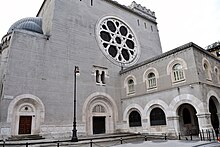
A synagogue, sometimes referred to by the Yiddish term shul and referred to by Reform communities as a temple, is a Jewish house of worship. Synagogues have a place for prayer, where Jews attend religious services or special ceremonies, have rooms for study, social hall(s), administrative and charitable offices, classrooms for religious school and Hebrew school, sometimes Jewish preschools, and often have many places to sit and congregate; display commemorative, historic, or modern artwork throughout; and sometimes have items of some Jewish historical significance or history about the synagogue itself on display.

Synagogue architecture often follows styles in vogue at the place and time of construction. There is no set blueprint for synagogues and the architectural shapes and interior designs of synagogues vary greatly. According to tradition, the Shekhinah or divine presence can be found wherever there is a minyan, a quorum, of ten. A synagogue always contains an Torah ark where the Torah scrolls are kept, called the aron qodesh by Ashkenazi Jews and the hekhal by Sephardic Jews.

The Old New Synagogue, also called the Altneuschul, situated in Josefov, Prague, is Europe's oldest active synagogue. It is also the oldest surviving medieval synagogue of twin-nave design.

The Synagogue of Santa María la Blanca or Ibn Shoshan Synagogue is a museum and former synagogue in Toledo, Spain. Erected in the late twelfth or early thirteenth century, it is disputably considered the oldest synagogue building in Europe still standing. The building was converted to a Catholic church in the early 15th century.
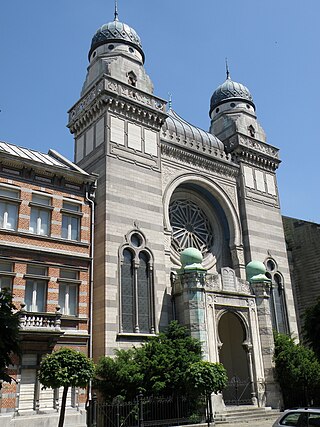
The Synagogue Shomré Hadas, commonly known as the Hollandse Synagoge. is a Modern Orthodox synagogue built in Antwerp, Belgium. The building is so named because it was commissioned by descendants of Jews who came to Antwerp from the Netherlands in the early 19th century. It was the first large synagogue in Antwerp. Today the synagogue is used for services only on Rosh Hashana, Yom Kippur and Shabbat morning service.

The Old Synagogue in Dubrovnik, Croatia, is the oldest Sefardic synagogue still in use today in the world and the second oldest synagogue in Europe. It is said to have been established in 1352, but gained legal status in the city in 1408. Owned by the local Jewish community, the main floor still functions as a place of worship for the High Holy Days and special occasions, but is now mainly a city museum which hosts numerous Jewish ritual items and centuries-old artifacts.

Heaton Park Hebrew Congregation is a large Ashkenazi Orthodox synagogue located in North Manchester, United Kingdom. It was founded in 1935, and in 2010 had between 500 and 749 members. Under the aegis of the Chief Rabbi of the United Kingdom, Reverend Leslie Olsberg MBE led the congregation for 35 years until his death in 2008. Rabbi Daniel Walker succeeded him, and currently heads the congregation. Yehuda Marx is the hazzan.

The Jakab and Komor Square Synagogue in Subotica is a Hungarian Art Nouveau synagogue in Subotica, Serbia. It is the second largest synagogue in Europe after the Dohány Street Synagogue in Budapest. It was built in 1901–1902 during the administration of the Kingdom of Hungary, according to the plans of Marcell Komor and Dezső Jakab replacing a smaller and less elaborate synagogue. It is one of the finest surviving pieces of religious architecture in the art nouveau style. It served the local Neolog community.
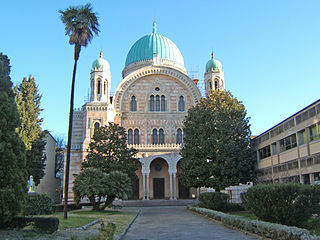
The Great Synagogue of Florence is one of the largest synagogues in South-central Europe, situated in Florence, in Italy. The synagogue of Florence was one of the most important synagogues built in Europe in the age of the Jewish emancipation, reached by the Jewish communities living in the Grand Duchy of Tuscany in 1848.
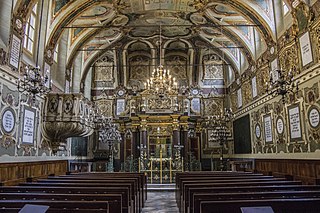
The Synagogue of Casale Monferrato is a 16th-century synagogue located in Vicolo Salmone Olper in the traditionally Jewish quarter of Casale Monferrato, Province of Alessandria, region of Piedmont, Italy.

The Izaak Synagogue, formally known as the Isaak Jakubowicz Synagogue, is an Orthodox Jewish synagogue from 1644 situated in the historic Kazimierz district of Kraków, Poland. The synagogue is named for its donor, Izaak Jakubowicz, also called Isaac the Rich, a banker to King Ladislaus IV of Poland. The synagogue was designed by Italian-born architect Francesco Olivierri.

The Dollis Hill Synagogue is a former Orthodox Jewish house of worship in Dollis Hill, London, England.
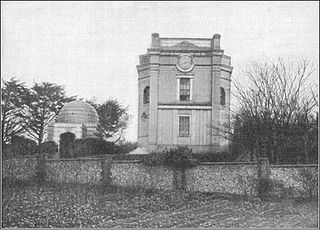
The Montefiore Synagogue is the former private synagogue of Sir Moses Montefiore. It is an 1833, Grade II* listed building in Ramsgate, Kent, England. The synagogue and mausoleum are cared for and maintained by the Montefiore Endowment. The endowment also maintains the nearby Ramsgate Jewish Cemetery.

The Włodawa Synagogue in Włodawa, Poland is an architectural complex consisting of two historic synagogues and a Jewish administrative building, now preserved as a museum. The complex includes the Włodawa Great Synagogue of 1764–74, the late 18th century Small Synagogue, and the 1928 community building. It is "one of the best-preserved" synagogues in Poland.

The Łańcut Synagogue is a Baroque synagogue in Łańcut, Poland. The Łańcut Synagogue is a rare surviving example of the vaulted synagogues with a bimah-tower, that were built throughout the Polish lands in masonry from the sixteenth through the early nineteenth centuries.
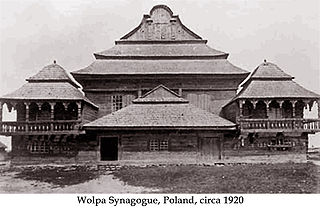
The Wołpa Synagogue was a synagogue located in the town of Voŭpa, in what is now western Belarus. It was reputed to be the "most beautiful" of the wooden synagogues of the former Polish–Lithuanian Commonwealth, a "masterwork" of wooden vernacular architecture.

Vowpa is a town in Vawkavysk District, Grodno Region, Belarus.

The Óbuda Synagogue is a synagogue built in Óbuda, Hungary, in 1820–1821.

The Cherasco Synagogue is the old synagogue of the Jewish community of Cherasco, Italy.

The Split Synagogue in Split, Croatia is one of the oldest Sefardic synagogue still in use today. It was built in the early 1500s.
